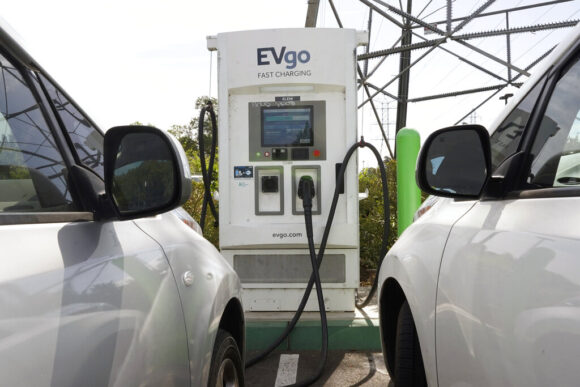A state mandate in California that will require all cars sold after 2035 to be emission free presents a formidable challenge for auto insurers to properly price and fully understand the risks presented by electric vehicles.
The rule adopted by the California Air Resources Board comes as average collision repair wait times are lengthening and repair costs are rising, said Susanna Gotsch, an analyst with CCC Intelligent Solutions. CCC data shows that electric vehicle repairs generally take longer and are more expensive.
Electric vehicles also present new kinds of risks. The propensity of defective lithium batteries to self-ignite is well known, which is why recall notices for electric cars often come with instructions to park the vehicle outside until the defect is fixed.
Consumers may be less aware that their vehicles can be hacked while connected to public charging stations, said Sandee Perfetto, senior director, personal lines,

products underwriting solutions for Verisk. She said there is even potential for “mass hacking events” that could cause more than $10 billion in losses.
California is already well ahead the rest of the United States in electric vehicle adoption. Electric vehicles made up 15.1% of all passenger vehicles sold in the state during the first half of 2022, according to the California Auto Dealers Association, compared to 5% for the nation as a whole.
Gotsch, who is senior director of insight and analytics for CCC, said the California directive will force a more rapid adoption of the technology than market forces alone might provide. After the California Air Resources Board announced the zero-emission mandate on Aug. 24, state leaders in Washington state and Massachusetts announced that they will also eliminate sales of all gasoline-powered cars by that date.
Gotsch said the challenge for insurers is that electric cars up until recently have represented only a tiny fraction of private passenger automobile sales, meaning loss history data is sparse.
CCC reported last month that the data is has collected so far shows that the average vehicle repair cost of $4,041 for non-luxury electric cars was 26.6% greater than for gasoline-powered cars. Repair times for electric vehicles averaged 31 days vs. 28 days for gasoline-powered.
Gostch said a mandate for a state the size of California will require automakers to adopt by offering a wider range of electric vehicles at various price points. Until now, she said, electric vehicles have trended toward the luxury and high-performance market.
Gotsch said the transformation from the internal combustion engine to battery-electric power is unprecedented in automotive history. She said the closest analogy that comes to mind is the evolution from unibody construction to body-on-frame during the 1980s and 1990s. Gotsch said that transition was gradual and driven by market forces, giving collision repair shops ample time to adapt.
Insurers have no choice but to adapt. “If you’re going to underwrite cars in California, this is the new norm.”
The government-mandated transition to electric power might be jolting., Gotsch said the workforce for the collision-repair industry, much like the insurance industry, is aging. Repair shops are finding it more difficult to recruit new workers to the field. She said collision repair shop owners have told her that electric vehicles are not inherently more difficult to repair, but extensive training is required.
“You’re talking about a whole new subset of vehicles that will have a new set of demands,” she said.
And a whole new set of risks.
Verisk’s Perfetto said electric vehicles become a part of the Internet of Things ecosystem when they connect to public charging stations, which makes them vulnerable to hackers.
Earlier this year, researchers with the University of Oxford in the United Kingdom and Armasuisse, a government agency in Switzerland, reported that the combined charging systems used in Europe and the United States can easily be attacked with off-the-shelf radio hardware. The researchers said hackers can “stealthily” deactivate the chargers by sending a signal from several yards away.
Even worse, hackers in the UK hacked into a popular electric vehicle charging network, a vulnerability that potentially exposed the personal data of customers who used used its equipment, according to Which?, an online British news site.
ARSTechnica, a website that tracks technology, reported on the potential for mischief in a July report. Joe Marshall, a security researcher for Cisco Talus, said vendors who operate electric charging stations communicate over the internet to process payments and perform maintenance. But he said many of the vendors use poor security practices, which allows hackers to exploit interfaces, the website reported.
Perfetto said some electric vehicles — as well as a few gasoline-powered models — have another odd glitch that can make car theft more likely in some instances. They use a fob instead of a key for security. In many models, the mirrors fold back into the car when the driver leaves the vehicle with the fob on his or her person.
But when drivers leave the fob in the car, the mirrors remain in the outward position. She said savvy car thieves have learned how to recognize cars with the fobs left inside.
“This changes the risk level for risk,” she said.
Was this article valuable?
Here are more articles you may enjoy.


 First Brands Judge Approves Examiner to Probe Fraud Allegations
First Brands Judge Approves Examiner to Probe Fraud Allegations  Tesla, EEOC Plan Talks to Settle Factory Racism Suit
Tesla, EEOC Plan Talks to Settle Factory Racism Suit  Musk’s xAI Faces California AG Probe Over Grok Sexual Images
Musk’s xAI Faces California AG Probe Over Grok Sexual Images  Palantir Poaching Suit Called ‘Scare’ Tactic by Ex-Employees
Palantir Poaching Suit Called ‘Scare’ Tactic by Ex-Employees 